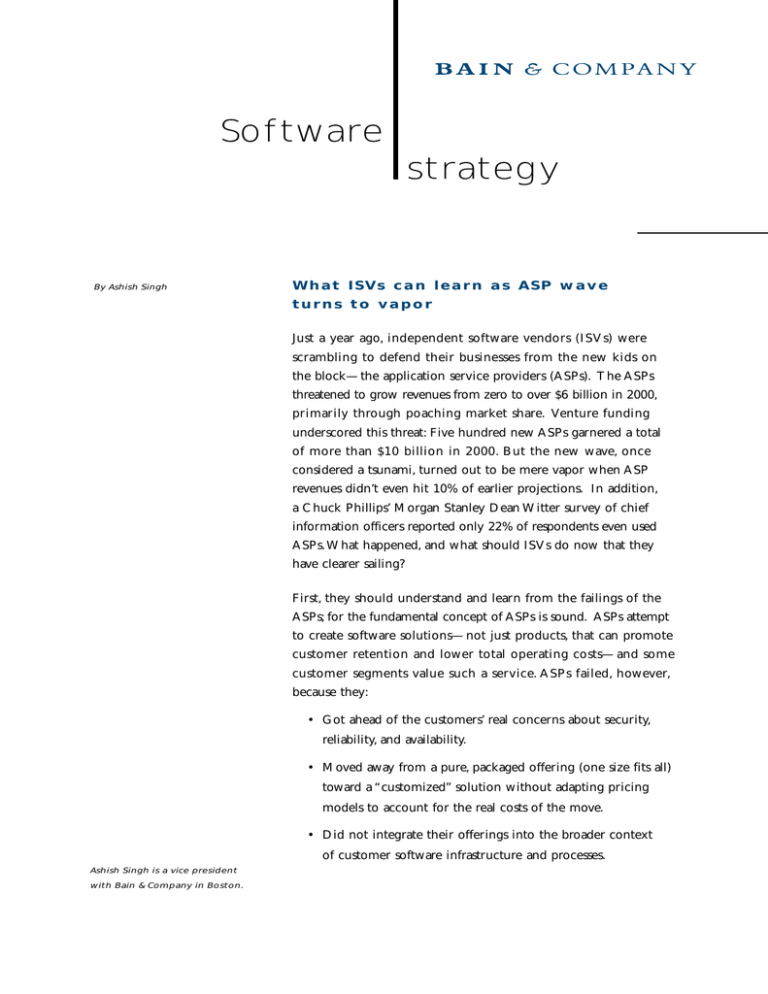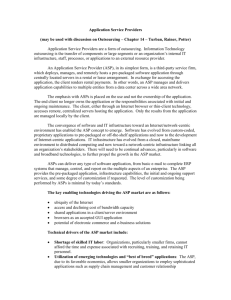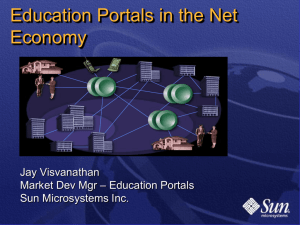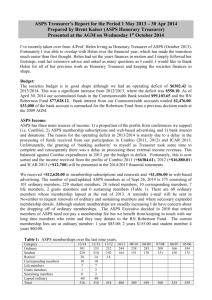Software strategy W h a t I S V s ... t u r n s t o ...
advertisement

Software strategy By Ashish Singh What ISVs can learn as ASP wave turns to vapor Just a year ago, independent software vendors (ISVs) were scrambling to defend their businesses from the new kids on the block—the application service providers (ASPs). The ASPs threatened to grow revenues from zero to over $6 billion in 2000, primarily through poaching market share. Venture funding underscored this threat: Five hundred new ASPs garnered a total of more than $10 billion in 2000. But the new wave, once considered a tsunami, turned out to be mere vapor when ASP revenues didn’t even hit 10% of earlier projections. In addition, a Chuck Phillips’ Morgan Stanley Dean Witter survey of chief information officers reported only 22% of respondents even used ASPs. What happened, and what should ISVs do now that they have clearer sailing? First, they should understand and learn from the failings of the ASPs; for the fundamental concept of ASPs is sound. ASPs attempt to create software solutions—not just products, that can promote customer retention and lower total operating costs—and some customer segments value such a service. ASPs failed, however, because they: • Got ahead of the customers’ real concerns about security, reliability, and availability. • Moved away from a pure, packaged offering (one size fits all) toward a “customized” solution without adapting pricing models to account for the real costs of the move. • Did not integrate their offerings into the broader context of customer software infrastructure and processes. Ashish Singh is a vice president with Bain & Company in Boston. ASPs are ideally suited to bringing new customer 2 Integrate the ASP offering into the existing, segments to the market, such as small- and medium- multichannel business model, focusing on the right sized companies without in-house infrastructures customer segments. Innovative ISVs are employing (the average ASP customer has less than 1000 their ASP offer ings in several creative ways. employees). However, network security concerns Examples include: using them as proof-of-concept prevent companies from using ASPs for mission- demos for selling the core product; reaching critical applications, such as enterprise resource smaller teams within existing large customers; planning, customer relationship management, and and reaching out to new customers altogether. sales force automation. These security issues will Success hinges on recognizing the potential of likely remain roadblocks for the next two-to-three ASPs to reach small- and medium-sized businesses years, because most companies fear taking critical cost-effectively. And it hinges on encouraging data and applications outside their firewalls. behavior within the existing field/ tele/channel Meanwhile, the ISVs misperceived the ASP threat because they: • Saw ASP moves as an attempt at a radically new business model, instead of a simple expansion of distr ibution in their core, multichannel businesses. (Traditional retailers similarly misperceived Internet retailing at the outset.) part of the overall integrated sales model. 3 Ensure integration with customer software infrastructure, via focused (limited scope) and service-assisted implementations to demonstrate early results and enable smaller, easier-to-digest process changes. 4 Address the very real secur ity concerns of • Were unwilling to fully adapt their own core products to address the ASPs’ target customer segments and thereby capture potential, incremental revenue for themselves. So, what should ISVs do now? Whether they are application providers or software-development-tool vendors, they should start with the following four initiatives: customers, by adopting the latest encryption and security standards and by building innovative, hosted service offerings that operate within customer firewalls. Building a brand trusted for security can create a barrier-to-entry against startups. 5 Define bundles of preferred solutions and create and/or work with “super ASPs” (likely the major system integrators) to offer the convenience of nearly one-stop shopping to enterprise customers. 1 Redesign their core products to function effectively over the Internet. This means using emerging Web service “standards” (XML, WebDav, .NET, etc.) and realizing the true potential of thin-client computing vs. a typical offer of traditional client/server architecture, force-fitted for the Web. B a i n & C o m p a n y, I n c . sales forces to use the ASP channel seamlessly as Software strategy The ISVs have some breathing room-but the time to act is right now. A new wave of ASPs, with services and applications optimized for Web delivery, built from the ground up, is gathering momentum. And this one will be harder to withstand if incumbent ISVs have not established their own, strong positions. 2 Bain & Company: Strategy for sustainable results Bain’s business is making companies more valuable. We convert strategy and action into economic performance. We were founded almost 30 years ago on the principle that consultants must measure their success in terms of their clients’ financial results. We put ourselves on the line right alongside our clients. We accept equity as part of our fees, and compensate our partners on clients’ financial results. So at Bain, instead of the usual consultants’ reports, you get: • Solutions that matter. So you can see the highest returns. • Strategies that work. So you get better results, faster. • Results that last. So momentum keeps building. • People you can work with. So the right things get done—and get done right. Because of who our clients are and what we do for them, we have been part of some of the most visible breakthroughs and turnarounds in history. Our clients outperform the stock market 3 to 1. BAIN & COMPANY, INC. Two Copley Place Boston, Massachusetts 02116 1 (617) 572 2000 Amsterdam Milan • • Atlanta Munich • • Beijing New York • • Boston Paris • • Brussels Rome • • Chicago San Francisco • • Dallas • São Paulo Hong Kong • Seoul • • Johannesburg Singapore • • London Stockholm • • Los Angeles Sydney • Tokyo • • Madrid Toronto Mexico City • • Zurich







